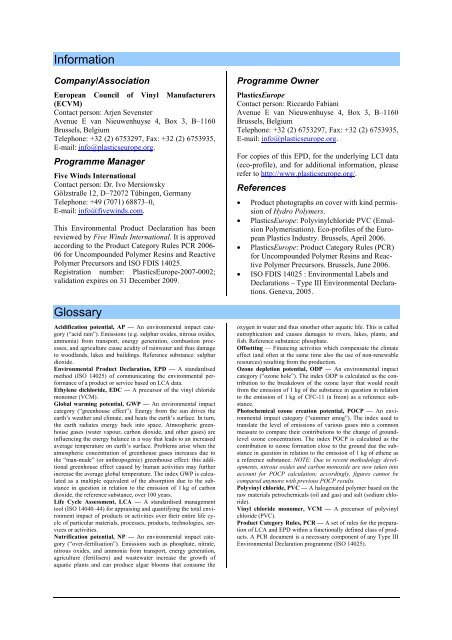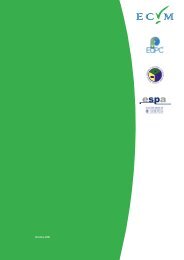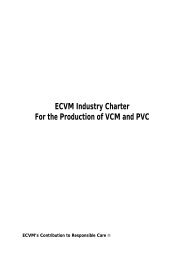EPD E-PVC Final Draft 2007-10-26 - PVC Info
EPD E-PVC Final Draft 2007-10-26 - PVC Info
EPD E-PVC Final Draft 2007-10-26 - PVC Info
Create successful ePaper yourself
Turn your PDF publications into a flip-book with our unique Google optimized e-Paper software.
<strong>Info</strong>rmation<br />
Company/Association<br />
European Council of Vinyl Manufacturers<br />
(ECVM)<br />
Contact person: Arjen Sevenster<br />
Avenue E van Nieuwenhuyse 4, Box 3, B–1160<br />
Brussels, Belgium<br />
Telephone: +32 (2) 6753297, Fax: +32 (2) 6753935,<br />
E-mail: info@plasticseurope.org.<br />
Programme Manager<br />
Five Winds International<br />
Contact person: Dr. Ivo Mersiowsky<br />
Gölzstraße 12, D–72072 Tübingen, Germany<br />
Telephone: +49 (7071) 68873–0,<br />
E-mail: info@fivewinds.com.<br />
This Environmental Product Declaration has been<br />
reviewed by Five Winds International. It is approved<br />
according to the Product Category Rules PCR 2006-<br />
06 for Uncompounded Polymer Resins and Reactive<br />
Polymer Precursors and ISO FDIS 14025.<br />
Registration number: PlasticsEurope-<strong>2007</strong>-0002;<br />
validation expires on 31 December 2009.<br />
Glossary<br />
Acidification potential, AP — An environmental impact category<br />
(“acid rain”). Emissions (e.g. sulphur oxides, nitrous oxides,<br />
ammonia) from transport, energy generation, combustion processes,<br />
and agriculture cause acidity of rainwater and thus damage<br />
to woodlands, lakes and buildings. Reference substance: sulphur<br />
dioxide.<br />
Environmental Product Declaration, <strong>EPD</strong> — A standardised<br />
method (ISO 14025) of communicating the environmental performance<br />
of a product or service based on LCA data.<br />
Ethylene dichloride, EDC — A precursor of the vinyl chloride<br />
monomer (VCM).<br />
Global warming potential, GWP — An environmental impact<br />
category (“greenhouse effect”). Energy from the sun drives the<br />
earth’s weather and climate, and heats the earth’s surface. In turn,<br />
the earth radiates energy back into space. Atmospheric greenhouse<br />
gases (water vapour, carbon dioxide, and other gases) are<br />
influencing the energy balance in a way that leads to an increased<br />
average temperature on earth’s surface. Problems arise when the<br />
atmospheric concentration of greenhouse gases increases due to<br />
the “man-made” (or anthropogenic) greenhouse effect: this additional<br />
greenhouse effect caused by human activities may further<br />
increase the average global temperature. The index GWP is calculated<br />
as a multiple equivalent of the absorption due to the substance<br />
in question in relation to the emission of 1 kg of carbon<br />
dioxide, the reference substance, over <strong>10</strong>0 years.<br />
Life Cycle Assessment, LCA — A standardised management<br />
tool (ISO 14040–44) for appraising and quantifying the total environment<br />
impact of products or activities over their entire life cycle<br />
of particular materials, processes, products, technologies, services<br />
or activities.<br />
Nutrification potential, NP — An environmental impact category<br />
(“over-fertilisation”). Emissions such as phosphate, nitrate,<br />
nitrous oxides, and ammonia from transport, energy generation,<br />
agriculture (fertilisers) and wastewater increase the growth of<br />
aquatic plants and can produce algae blooms that consume the<br />
Programme Owner<br />
PlasticsEurope<br />
Contact person: Riccardo Fabiani<br />
Avenue E van Nieuwenhuyse 4, Box 3, B–1160<br />
Brussels, Belgium<br />
Telephone: +32 (2) 6753297, Fax: +32 (2) 6753935,<br />
E-mail: info@plasticseurope.org.<br />
For copies of this <strong>EPD</strong>, for the underlying LCI data<br />
(eco-profile), and for additional information, please<br />
refer to http://www.plasticseurope.org/.<br />
References<br />
• Product photographs on cover with kind permission<br />
of Hydro Polymers.<br />
• PlasticsEurope: Polyvinylchloride <strong>PVC</strong> (Emulsion<br />
Polymerisation). Eco-profiles of the European<br />
Plastics Industry. Brussels, April 2006.<br />
• PlasticsEurope: Product Category Rules (PCR)<br />
for Uncompounded Polymer Resins and Reactive<br />
Polymer Precursors. Brussels, June 2006.<br />
• ISO FDIS 14025 : Environmental Labels and<br />
Declarations – Type III Environmental Declarations.<br />
Geneva, 2005.<br />
oxygen in water and thus smother other aquatic life. This is called<br />
eutrophication and causes damages to rivers, lakes, plants, and<br />
fish. Reference substance: phosphate.<br />
Offsetting — Financing activities which compensate the climate<br />
effect (and often at the same time also the use of non-renewable<br />
resources) resulting from the production.<br />
Ozone depletion potential, ODP — An environmental impact<br />
category (“ozone hole”). The index ODP is calculated as the contribution<br />
to the breakdown of the ozone layer that would result<br />
from the emission of 1 kg of the substance in question in relation<br />
to the emission of 1 kg of CFC-11 (a freon) as a reference substance.<br />
Photochemical ozone creation potential, POCP — An environmental<br />
impact category (“summer smog”). The index used to<br />
translate the level of emissions of various gases into a common<br />
measure to compare their contributions to the change of groundlevel<br />
ozone concentration. The index POCP is calculated as the<br />
contribution to ozone formation close to the ground due the substance<br />
in question in relation to the emission of 1 kg of ethene as<br />
a reference substance. NOTE: Due to recent methodology developments,<br />
nitrous oxides and carbon monoxide are now taken into<br />
account for POCP calculation; accordingly, figures cannot be<br />
compared anymore with previous POCP results.<br />
Polyvinyl chloride, <strong>PVC</strong> — A halogenated polymer based on the<br />
raw materials petrochemicals (oil and gas) and salt (sodium chloride).<br />
Vinyl chloride monomer, VCM — A precursor of polyvinyl<br />
chloride (<strong>PVC</strong>).<br />
Product Category Rules, PCR — A set of rules for the preparation<br />
of LCA and <strong>EPD</strong> within a functionally defined class of products.<br />
A PCR document is a necessary component of any Type III<br />
Environmental Declaration programme (ISO 14025).





